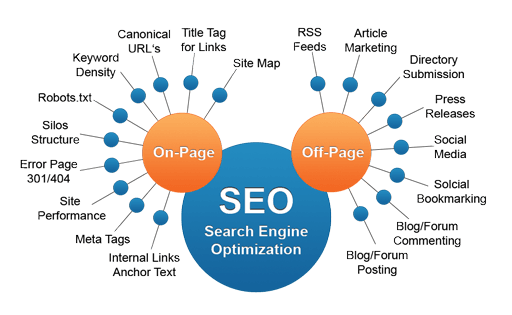
What is SEO in digital marketing
SEO, which stands for Search Engine Optimization, is a fundamental aspect of digital marketing. It refers to the process of optimizing a website to improve its visibility and ranking in search engine results pages (SERPs). The goal of SEO is to increase organic (non-paid) traffic to a website by ensuring that it appears higher in search engine results for relevant keywords and phrases.
Table of Contents
Types of SEO

- On-Page SEO: This type of SEO focuses on optimizing individual web pages to improve their visibility and ranking on search engine results pages (SERPs). It involves optimizing elements such as meta tags, headings, content, URL structure, and internal linking.
- Off-Page SEO: Off-Page SEO refers to activities done outside of the website to improve its visibility and ranking on search engines. This includes building high-quality backlinks from other websites, social media marketing, influencer outreach, and online reputation management.
- Technical SEO: Technical SEO involves optimizing the technical aspects of a website to improve its visibility and performance on search engines. It includes tasks such as website speed optimization, mobile-friendliness, crawlability, site structure, and XML sitemap creation.
These three types of SEO work together to improve a website’s visibility, attract organic traffic, and enhance its overall search engine rankings.
How to Do SEO

To perform SEO effectively, you can follow these steps:
- Keyword Research: Identify relevant keywords and phrases that your target audience is likely to search for. Use keyword research tools to find high-volume and low-competition keywords.
- On-Page Optimization: Optimize your website’s pages by incorporating target keywords into meta tags, headings, URL structure, and content. Ensure your content is high-quality, relevant, and engaging for users.
- Technical Optimization: Improve your website’s technical aspects, such as site speed, mobile-friendliness, and crawlability. Optimize your site’s structure, create XML sitemaps, and fix any broken links or errors.
- Content Creation: Develop high-quality, informative, and engaging content that aligns with your target keywords. Regularly update your website with fresh content to attract and retain visitors.
- Link Building: Build high-quality backlinks from reputable websites to increase your website’s authority and visibility. This can be done through guest blogging, influencer outreach, and creating shareable content.
- Social Media and Online Presence: Establish a strong presence on social media platforms to engage with your audience and promote your content. Share your website’s content and encourage social sharing.
- Monitoring and Analysis: Regularly monitor your website’s performance using analytics tools. Track keyword rankings, organic traffic, and user behavior to identify areas for improvement.
- Stay Updated: Stay informed about the latest SEO trends, algorithm updates, and best practices. SEO is an evolving field, so it’s important to adapt your strategies accordingly.
Remember, SEO is a long-term process, and results may take time. It’s crucial to be patient, consistent, and continuously optimize your website to improve its visibility and organic traffic over time.
What is SEO writing

SEO writing, also known as search engine optimization writing, is the practice of creating content that is optimized for search engines. The goal of SEO writing is to improve a webpage’s visibility and ranking on search engine results pages (SERPs) for specific keywords or phrases.
SEO writing involves incorporating target keywords strategically throughout the content, including in headings, meta tags, URL structure, and body text. However, it’s important to maintain a natural and reader-friendly writing style while optimizing for search engines.
Effective SEO writing involves:
- Keyword Research: Identifying relevant keywords and phrases that have high search volume and low competition.
- Keyword Placement: Incorporating target keywords in the title tag, meta description, headings, and throughout the content in a way that flows naturally.
- Quality Content: Creating high-quality, informative, and engaging content that provides value to the readers.
- Readability: Ensuring the content is easy to read and understand, with proper formatting, subheadings, and bullet points.
- User Intent: Understanding the intent behind the search queries and creating content that satisfies the user’s needs and provides relevant information.
- Linking: Incorporating internal and external links to provide additional context and credibility to the content.
- Regular Updates: Keeping the content up-to-date and relevant to maintain its visibility and ranking over time.
By following these practices, SEO writing aims to attract organic traffic from search engines, improve website visibility, and ultimately drive more targeted visitors to a webpage.
What is SEO marketing

SEO marketing, also known as search engine optimization marketing, is a digital marketing strategy aimed at improving a website’s visibility and ranking in search engine results pages (SERPs). The goal of SEO marketing is to increase organic (non-paid) traffic to a website by optimizing various aspects such as website content, structure, and technical elements.
SEO marketing involves several techniques and practices, including keyword research, on-page optimization, off-page optimization, link building, and content creation. By targeting relevant keywords and optimizing website elements, SEO marketing helps search engines understand the website’s content and rank it higher in search results.
The benefits of SEO marketing include increased website visibility, improved organic traffic, higher brand credibility, and better user experience. It is a long-term strategy that requires continuous monitoring, analysis, and adjustments to stay ahead of competitors and adapt to search engine algorithm updates.
SEO tips for beginners

Here are some SEO tips for beginners:
- Keyword Research: Start by conducting keyword research to identify relevant keywords and phrases that your target audience is searching for. Use keyword research tools to find high-volume and low-competition keywords.
- On-Page Optimization: Optimize your website’s pages by incorporating target keywords into meta tags, headings, URL structure, and content. Ensure your content is high-quality, relevant, and engaging for users.
- Content Creation: Develop valuable and informative content that aligns with your target keywords. Focus on creating content that answers common questions, provides solutions, and offers unique insights to your audience.
- Website Structure: Ensure your website has a clear and organized structure that is easy for both users and search engines to navigate. Use descriptive URLs, create a logical hierarchy with headings, and implement internal linking to improve user experience and search engine crawlability.
- Mobile-Friendliness: Optimize your website for mobile devices, as mobile usage continues to rise. Ensure your website is responsive, loads quickly on mobile devices, and provides a seamless user experience.
- Page Speed: Improve your website’s loading speed by optimizing image sizes, minimizing code, and leveraging caching techniques. A faster website not only improves user experience but also helps with search engine rankings.
- Link Building: Build high-quality backlinks from reputable websites in your industry. Focus on acquiring natural and relevant links through guest blogging, influencer outreach, and creating shareable content.
- Social Media Presence: Establish a strong presence on social media platforms to engage with your audience, promote your content, and build brand awareness. Social signals can indirectly impact search engine rankings.
- Monitor and Analyze: Regularly monitor your website’s performance using analytics tools. Track keyword rankings, organic traffic, and user behavior to identify areas for improvement and adjust your SEO strategy accordingly.
- Stay Informed: Stay updated with the latest SEO trends, algorithm updates, and best practices. Follow reputable SEO blogs, attend webinars, and join relevant communities to stay informed and continuously improve your SEO knowledge.
Remember, SEO is a long-term process, and results may take time. Be patient, consistent, and continuously optimize your website to improve its visibility and organic traffic over time.



One thought on “The Beginner’s Guide to What Is SEO”